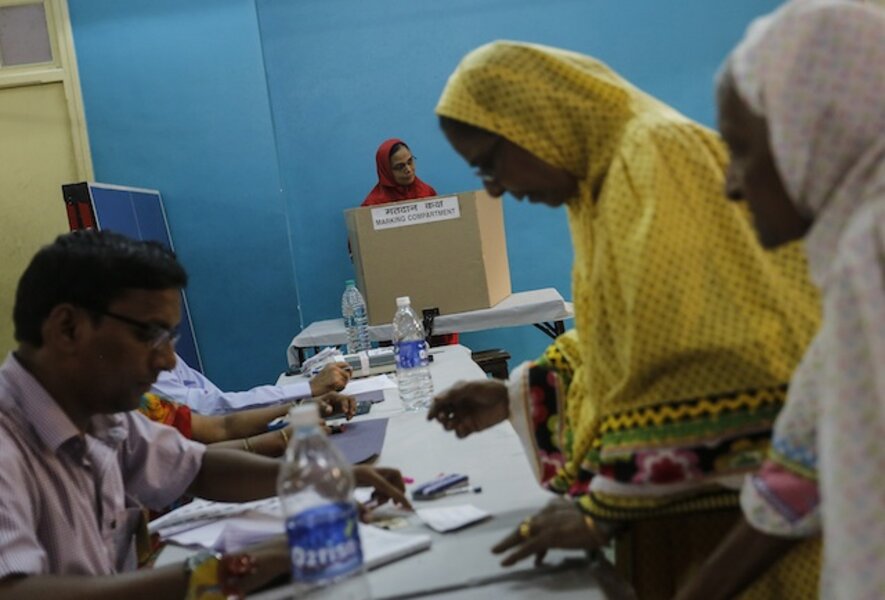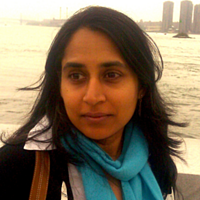Why India's Narendra Modi can't succeed without regional parties
Loading...
| Mumbai and Nagpur, India
When Narendra Modi, the man expected to be India's next prime minister, took the stage at a rally in Mumbai this week, it was not his face, but a picture of the late founder of the Shiv Sena, an influential regional party, that dominated the banners above him.
The Sena loyalists did want to get a glimpse of Modi, the marquee speaker. But they came to support their own party, just as the blue-scarved supporters of the party that represents Dalits, a caste group formerly known as “untouchables," came to hear their party chief.
The rally illustrated the considerable clout held by regional parties in Indian politics. That's especially true in states such as Tamil Nadu, Maharashtra, and West Bengal that voted today in the second biggest polling day in India's month-long election scheduled to end May 12.
Under India’s “first past the post” system, a party or alliance needs to get at least 272 of 545 parliament seats. India has not had single-party rule since 1989, making these regional and sub-regional parties key to the electoral jigsaw.
This year, voters in India’s elections are widely expected to boot out the ruling Congress-led United Progressive Alliance. But just how strong a government Modi's opposition Bharatiya Janata Party (BJP) can form depends on the number of seats it can pick up – and, critically, the alliances it can make with the 36 regional parties currently represented in the parliament.
Here’s what you need to know about the role that regional parties play in India’s elections:
They're relatively new, and 'regional' may be a misnomer.
Regional parties first began forming in the late 1960s in the wake of movements for new states. But they really took off in northern India in the late 1980s and early ‘90s, with the formation of parties that represented the interests of lower castes and minorities, including the Bahujan Samaj Party (BSP) and the Samajwadi Party in Uttar Pradesh – both of which ate into the big-tent Congress Party vote share.
“The emergence and growth of the regional parties marked the decline of the Congress as an umbrella organization able to meet the aspirations of different sections of society,” says political commentator Neerja Chowdhury.
Most so-called regional parties actually represent caste and community groups rather than express a regional identity. For instance, parties such as the Dravida Munnetra Kazhagam of Tamil Nadu lobbies for and implements expanded affirmative action for lower castes.
They can influence national policy hugely – including foreign policy.
India’s backing earlier this year of a UN resolution against Sri Lanka for human rights abuses was largely influenced by the southern state of Tamil Nadu. And Mamata Banerjee, the self-willed chief of West Bengal, the state that borders Bangladesh, last year scuttled a proposed water-sharing treaty between the two countries.
Some analysts consider this influence to be one of the downsides of regional party power, since state leaders don't always have a broader national perspective or may be too beholden to local pressures.
Regional parties have produced powerful, maverick women.
The parties have spawned some charismatic, strong state leaders including three women who tower over their respective states: Ms. Mayawati of the BSP Party in Uttar Pradesh, Mamata Banerjee of Trinamool Congress in West Bengal, and J. Jayalalithaa of AIADMK in Tamil Nadu. All three are heads of their parties, and two are heads of their states. The latter two have also expressed prime ministerial ambitions, with Ms. Jayalalithaa directly challenging Modi’s achievements in recent days.
“They are women who don’t belong to political families, who have made it mostly under their own steam,” says Ms. Chowdhury. “They’ve had to fight harder, struggle more. Yet they’ve survived and made a mark.”
This year’s election may buck the regional trend.
Opinion polls have found that the traditionally upper-caste BJP is polling well across castes and especially among young voters – 150 million people will be voting for the first time this election. Polls have also found that voters across regions and castes consistently raise national issues, such as economic growth and inflation.
Both of these polling trends suggest that caste and community identities are becoming less important. “Regional parties may be stagnating or may be coming down,” said Milan Vaishnav, an associate at the South Asia Program at the Carnegie Endowment for International Peace in Washington DC, who helped conduct a survey that produced similar findings in December.
One young retail store manager in Mumbai from a family of Sena supporters said that he wouldn’t vote for the party this time. “It’s outdated,” he said of the Sena’s focus on Maharashtrian identity and interests.






